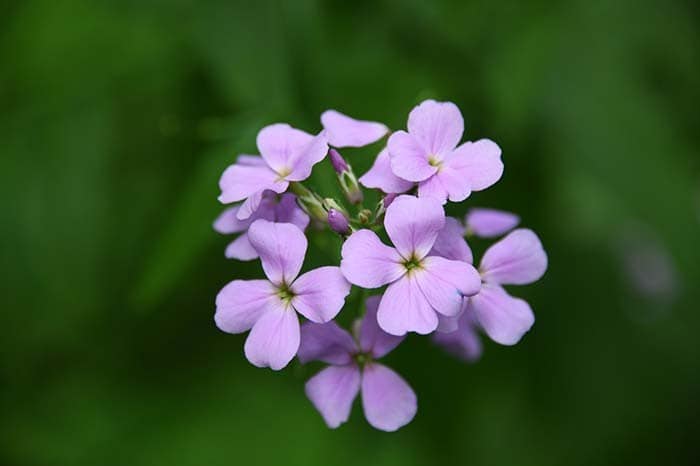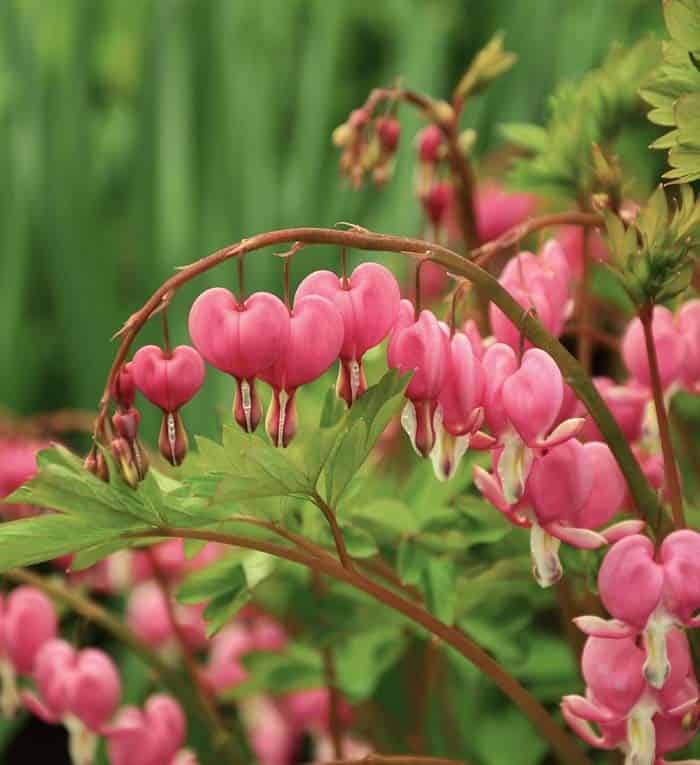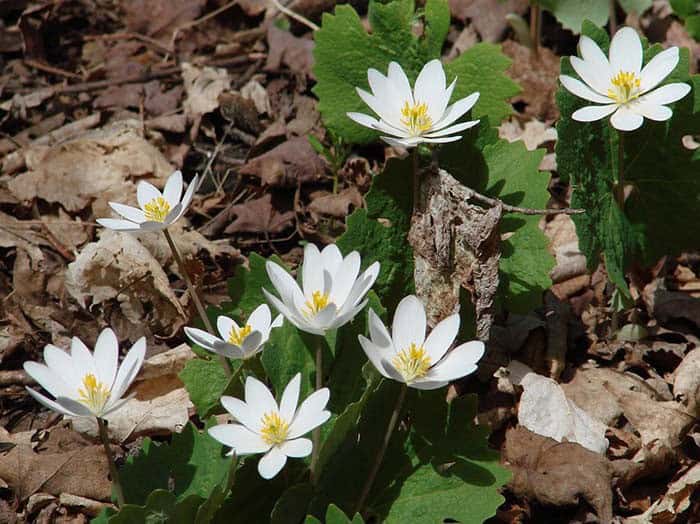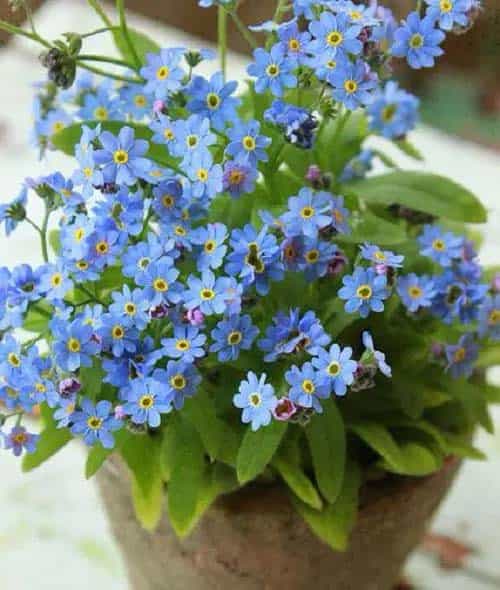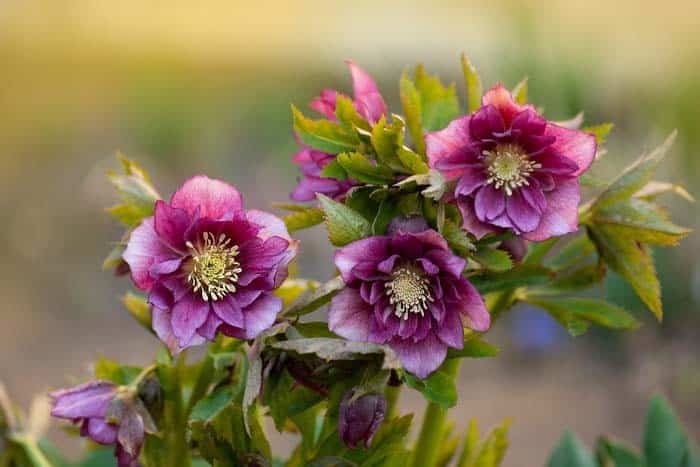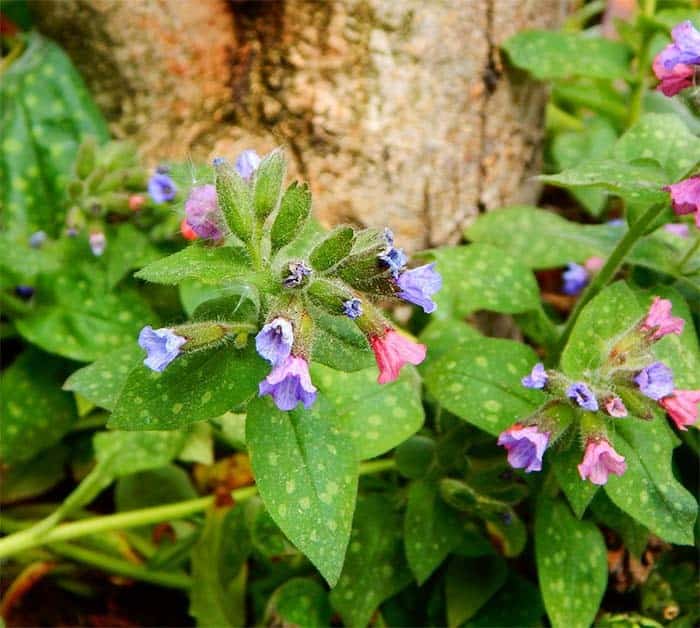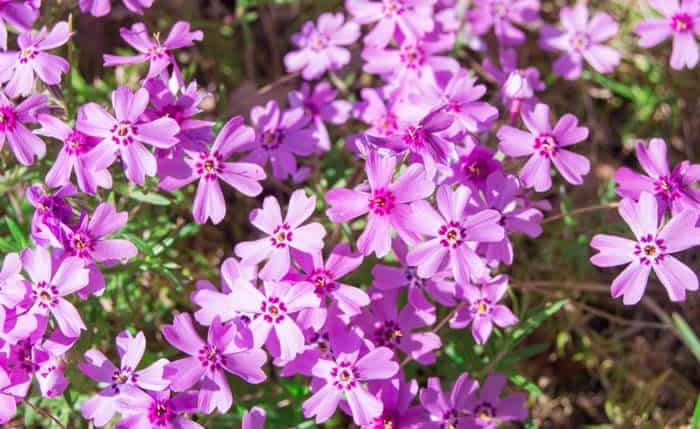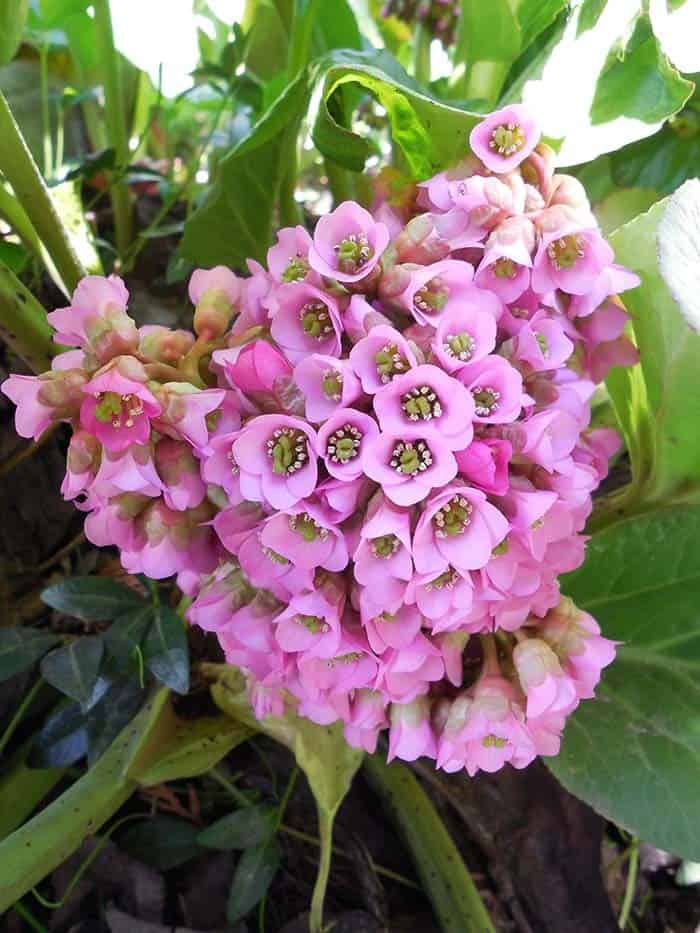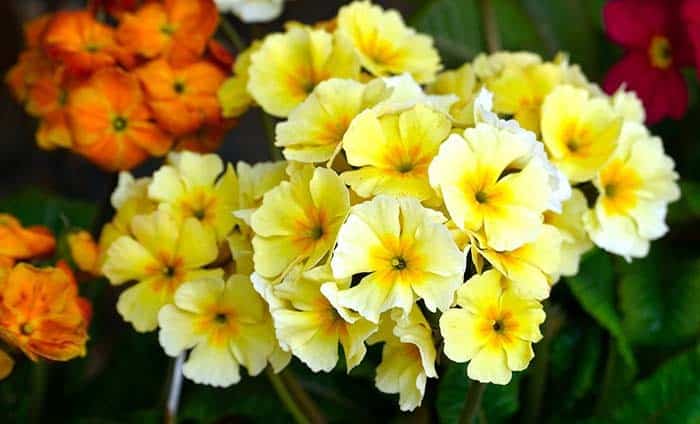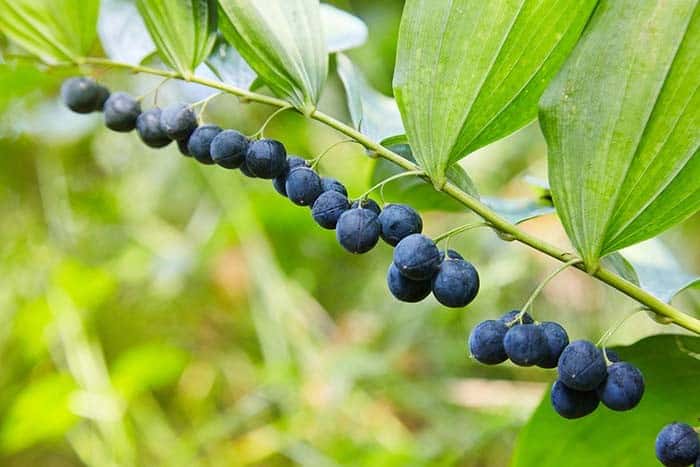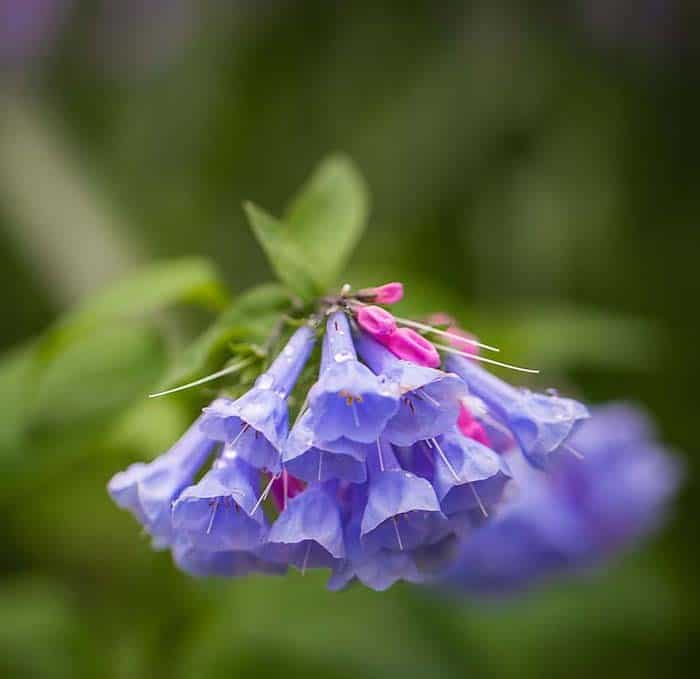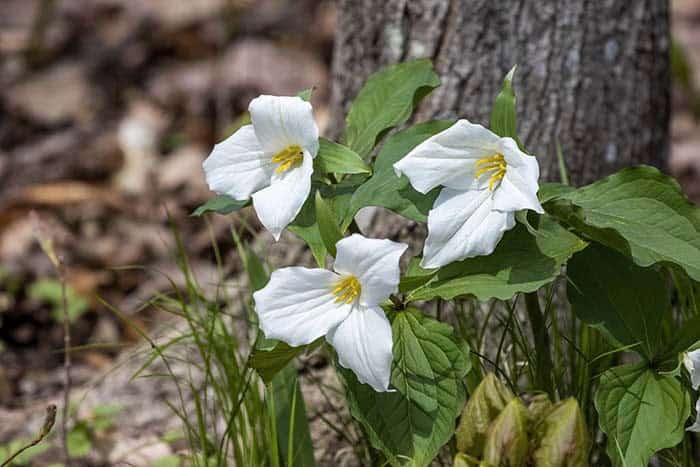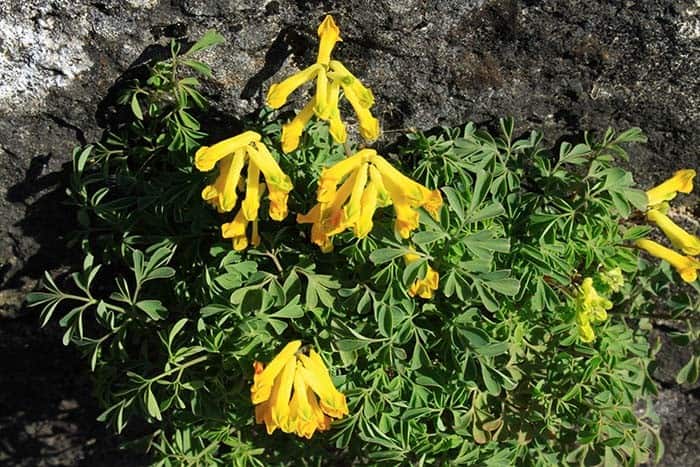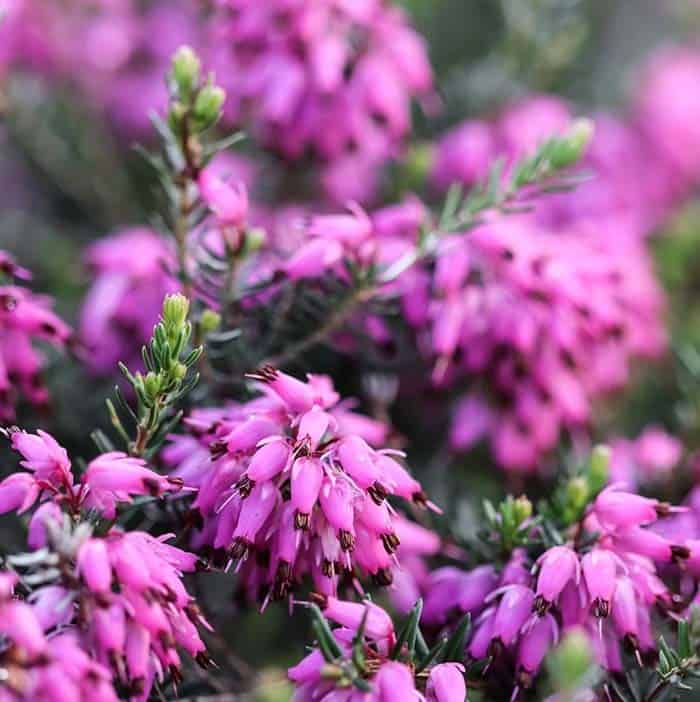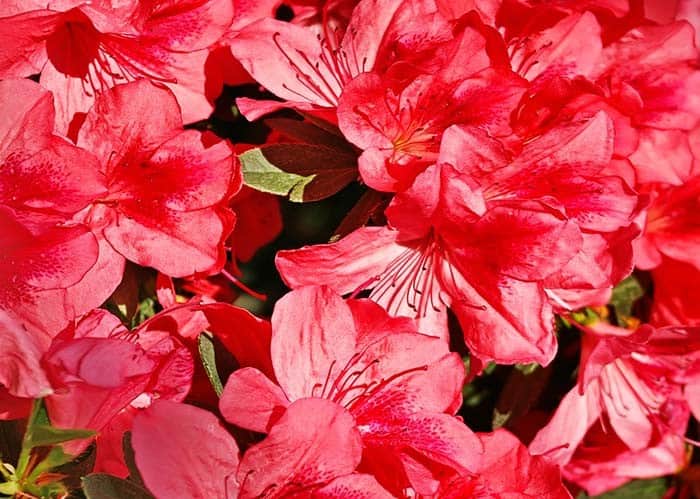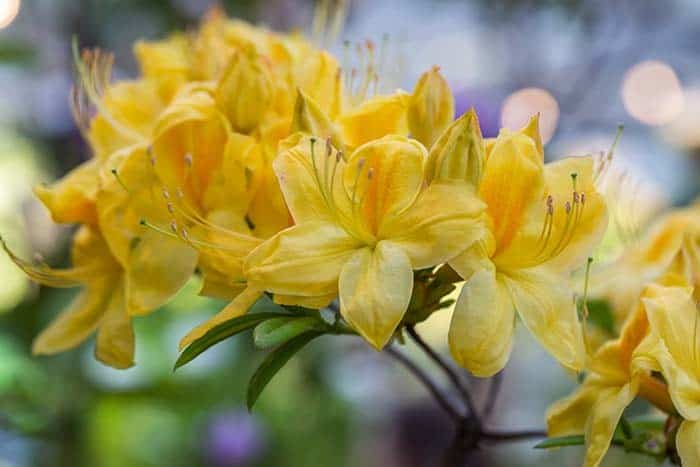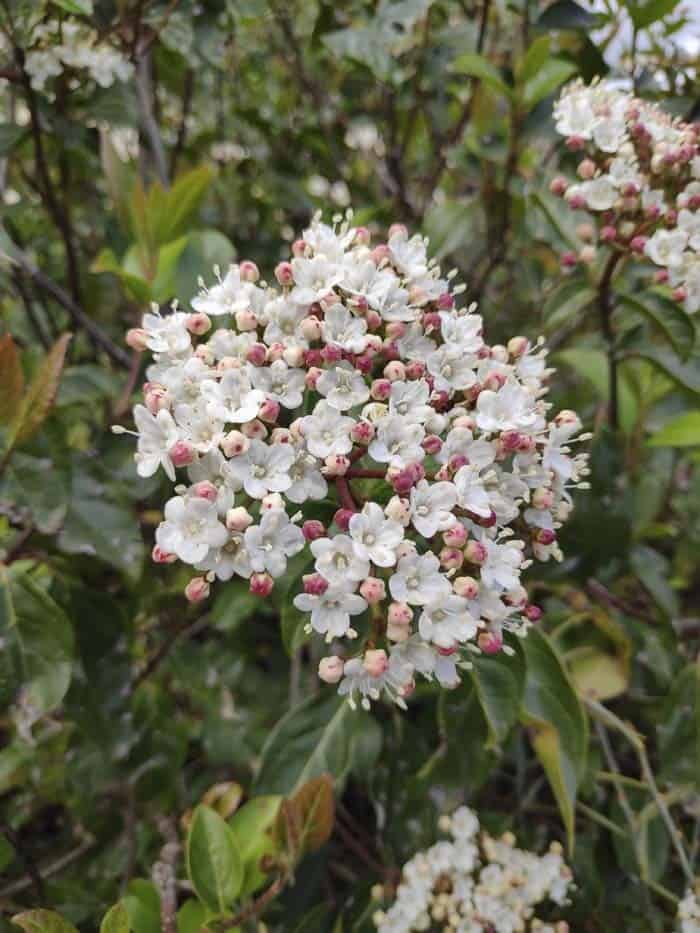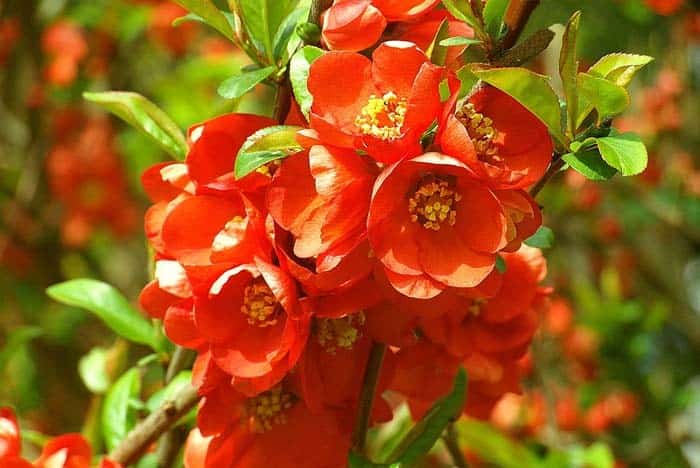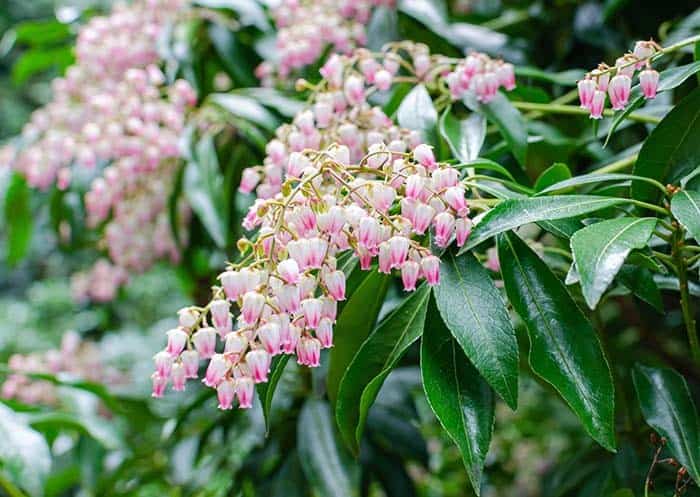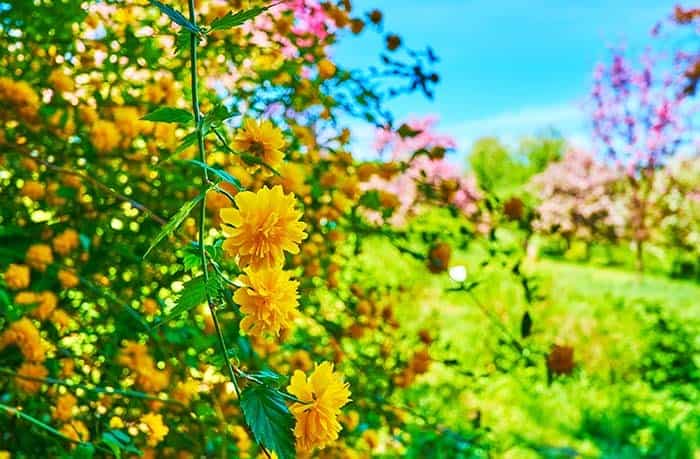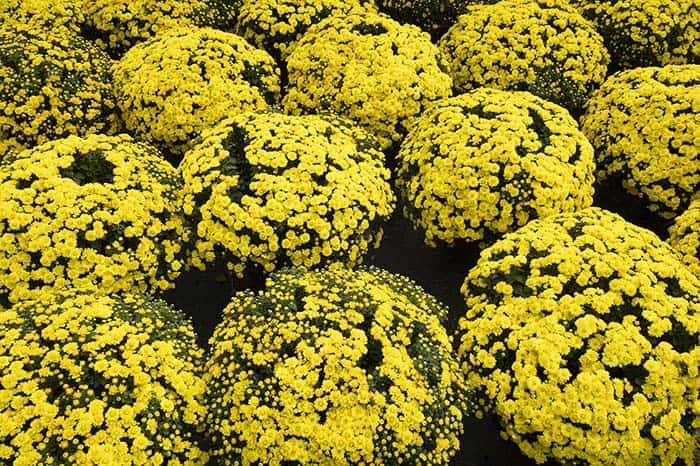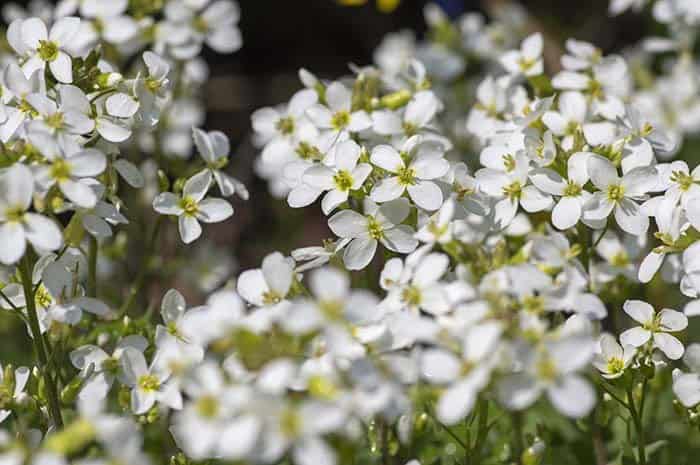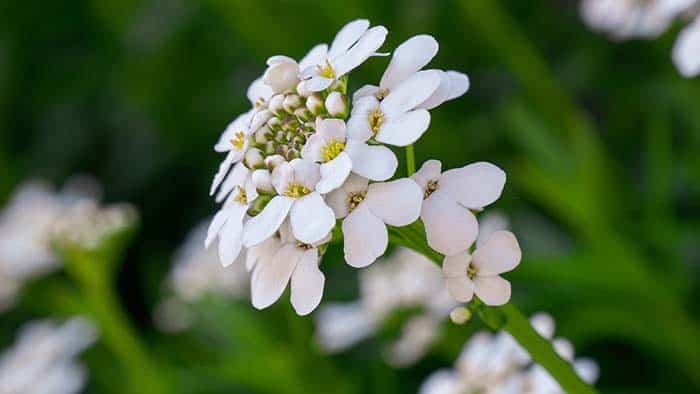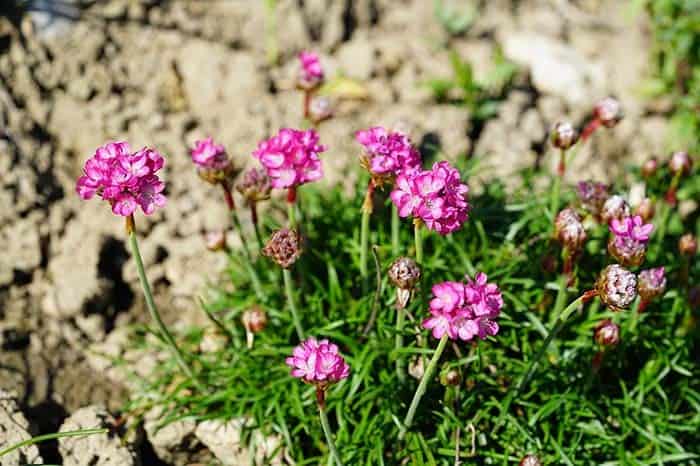As the warmth of spring approaches, greet it with a vibrant display of blooming flowers that can thrive in the unpredictable weather conditions. Here’s a curated selection of 25 early spring flowers, each capable of showcasing its stunning blossoms as soon as the temperature rises. This diverse collection includes low-growing ground covers and bushes, all hardy enough to adapt to the changing climate, ensuring your spring excitement builds with anticipation.
Bleeding Heart (Lamprocapnos spectabilis)
Bleeding Heart (Lamprocapnos spectabilis) is a stunning perennial that thrives in USDA growing zones 2 to 9. Its unique feature is the dangling heart-shaped blossoms, typically pink or red, which are supported by inclining branches resembling arms. The petals of each bloom split at the bottom, revealing a white teardrop tinged with yellow. This captivating plant requires moist, rich, and well-drained soil, as well as partial shade to full sun exposure.
To create a show-stopping display in your garden, consider planting multiple specimens together, allowing them to intertwine like a shrub and create a lush, romantic atmosphere.
Bloodroot (Sanguinaria canadensis)
The Bloodroot (Sanguinaria canadensis) thrives in USDA Growing Zones 3-8 and showcases an array of color with its white or pale pink petals accompanied by vibrant yellow centers. This charming perennial prefers full to partial shade and excels in rich, well-drained acidic soil conditions.
At first glance, the delicate white blooms may seem understated, but their striking appearance is undeniable. Interestingly, the plant’s name stems from the reddish sap that oozes out when its root is cut.
As a low-growing ground cover, Bloodroot requires minimal maintenance and displays a gentle demeanor, avoiding aggressive spread like some of its fellow flower family members. After the blooms have faded, the lush green foliage remains, creating a natural carpet that adds to the garden’s charm. It is essential to note that this plant is highly toxic, so careful planning is necessary when selecting its location in your outdoor space.
The sudden appearance of the Bloodroot’s white blossoms serves as an early indicator of warmer weather on the horizon.
Siberian Bugloss or False Forget-Me-Not (Brunnera macrophylla)
The majestic Blue-flowered plant thrives in USDA Growing Zones 3 to 8, where it can bask in part shade and flourish in rich, moist, well-drained soil conditions. This low-maintenance beauty is renowned for its stunning foliage and diminutive yet vibrant blue blooms, which emerge in early spring and persist until late summer if properly tended. As the leaves mature and eventually become tattered, a simple trimming will encourage new growth to take their place.
Hellebore (Helleborus spp.)
Hellebores are a type of winter-resistant, spring-blooming perennial that thrive in USDA Growing Zones 4-9, with specific species having varying requirements. These evergreen plants produce slow-growing foliage and can take a few years to bloom from seed, but the wait is well worth it as they offer stunning blossoms at the end of winter, sometimes even amidst snow cover.
When selecting Hellebore seeds, you’ll have the opportunity to choose from a range of color varieties, including pink, dark purple, maroon, white, yellow, cream, and bi-colored blooms. To ensure optimal growth, it’s essential to provide these plants with shelter from strong winds and partial to full shade.
Soil-wise, Hellebores require rich, moist, and well-draining conditions. By meeting these needs, you’ll be rewarded with a low-maintenance yet striking addition to your garden.
Lungwort (Pulmonaria spp.)
The Lungwort’s striking features are showcased through its bell-like blooms and impressive foliage. With growth zones spanning from 4 to 9, this plant thrives in a range of environments. The delicate white, pink, or blue flowers, depending on their stage of development, unfold against a backdrop of richly colored, spear-shaped leaves with silver accents. When pollination occurs, the blossoms transform into vibrant blue blooms, a natural phenomenon that is both fascinating and awe-inspiring.
To achieve optimal results, it’s essential to maintain consistent soil moisture levels in well-drained, rich soil conditions. This ensures the Lungwort’s tall stems, adorned with lush foliage, remain healthy and robust.
Creeping Phlox (Phlox subulata)
Creeping phlox (Phlox subulata) is a charming wildflower that thrives in USDA growing zones 3 to 9, producing an abundance of tiny blossoms in shades of pink, red, white, and purple. The delicate flowers are borne on tall sprigs with slender needle-like leaves that provide a beautiful backdrop for the colorful blooms. When planted en masse, this eye-catching formation is sure to draw attention, and the availability of seeds in pastel hues adds an extra layer of charm.
To coax the best from creeping phlox, plant it in rich soil that drains well, and ensure it receives full sun to partial shade. As for maintenance, simply remove weeds as they appear, keeping the area tidy and allowing the phlox to flourish. This early spring-blooming flower is a delight to behold, and with proper care, it will provide vibrant color and texture to your garden.
Pigsqueak (Bergenia cordifolia)
This perennial flower boasts attractive, heart-shaped leaves arranged in rosettes that retain their appeal throughout spring. The leaves’ unique trait lies in the audible ‘pig squeak’ sound produced when rubbed. Meanwhile, the flowers themselves are small but densely clustered, with a deep pink hue. The plant typically grows in dense clumps, either from seeds or rhizomes.
To thrive, it requires rich soil and moderate sunlight, making USDA Growing Zones 4 to 8 and partial shade ideal environments. Color variations include not only pink, but also white, red, and violet, allowing for creative garden design options. With proper care, this striking flower will bloom indefinitely.
Primrose (Primula spp.)
Primula, a sought-after plant species, boasts stunning ornamental flowers that thrive in USDA Growing Zones 4 to 8. Its vibrant blooms come in an array of colors including white, yellow, red, amber-orange, pink, purple, and several bicolored varieties. The ideal conditions for primula are partial shade, rich soil that’s slightly acidic, moist, and well-drained. As a bonus, the evergreen foliage provides year-round interest, with small blooms emerging in spring after autumn’s display.
To maximize its beauty, plant primula in large clumps to create a striking visual effect. In winter, the basal rosettes of leaves will add cheer, while warmer temperatures bring forth delicate flowers. When selecting a location for your primula, ensure the soil is not too heavy or rich, and provide adequate moisture to prevent waterlogged conditions.
Solomon’s Seal (Polygonatum spp.)
Solomon’s seal, a unique flowering plant, thrives in USDA zones 3 through 7. Its delicate beauty is showcased by clusters of dangling white blooms that drape elegantly from arm-like stems. After the blossoms fade, glossy black seeds take their place, falling to the ground where they self-seed for future growth. This charming perennial is one of the earliest spring-bloomers, preferring rich, moist soil with a neutral to slightly acidic pH and partial to full shade.
Twinleaf (Jeffersonia diphylla)
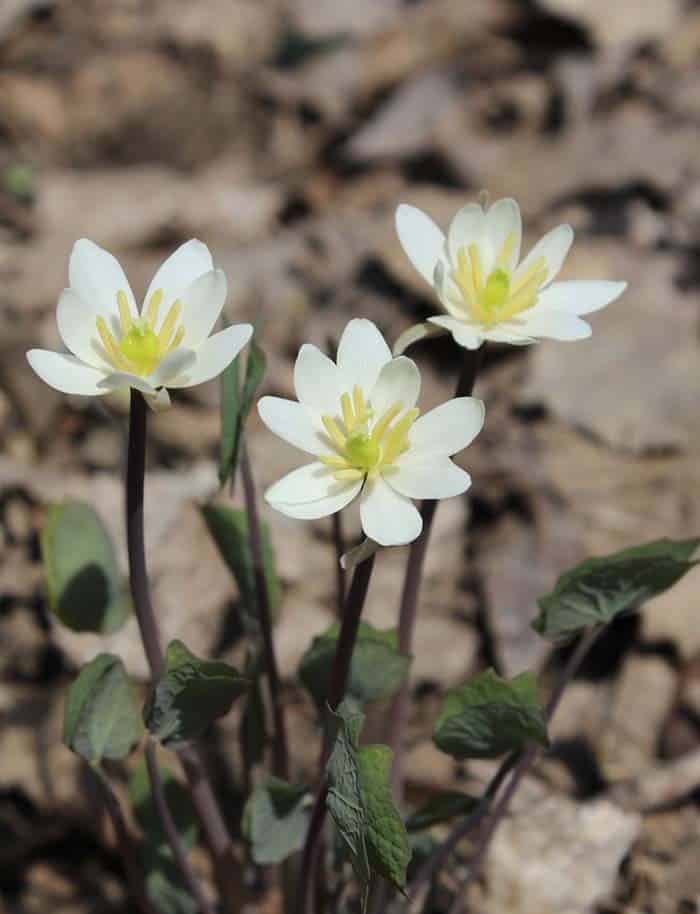
The Twinleaf (Jeffersonia diphylla) is a plant that thrives in USDA Growing Zones 5 to 7, producing white blooms on stems that reach heights beyond those of its close relative, Bloodroot. One of the key differences between the two plants is the size and coloration of their leaves. The Twinleaf’s foliage is smaller and darker than Bloodroot’s, making it a unique addition to any garden.
This North American native does well in partial to full shade, where it can soak up moisture and cooler temperatures. To replicate its natural environment, simply cover the soil with a layer of mulch to maintain these conditions. One of the most striking features of the Twinleaf is its name, which originates from the arrangement of leaves at the base of the stem. Here, you’ll find two sets of two leaves that form a butterfly-like shape, earning Jeffersonia diphylla its other name.
Virginia Bluebells (Mertensia virginica)
The Bluebell (Hyacinthoides spp.) is a charming perennial flower that thrives in USDA growing zones 3 to 8. Its unique charm lies in its ability to transform from pink buds to lavender-blue blossoms, a phenomenon that occurs as the flowers mature. The bell-shaped blooms cluster together, forming a heavy load that causes the stem to bend downwards. This fleeting beauty is one of the earliest spring-flowering plants, typically disappearing shortly after blooming.
Despite its short-lived nature, the Bluebell remains a beloved symbol of spring’s arrival, with its delicate white, lavender, and pink color varieties thriving in part shade to full shade conditions. The soil requirements are evenly moist, well-drained, and slightly sandy.
Wood Lily (Trillium grandiflorum)
White Trillium, a spring-blooming gem, thrives in USDA Growing Zones 4 to 8. Its striking features include large, long-lasting white blossoms that emerge on stems adorned with three ovate leaves. The plant’s flowering period typically spans April and early summer, during which the blooms gradually turn pale pink as they age. Notably, White Trillium prefers partial shade to full shade and rich, moist, well-drained soil, making it an ideal choice for wildflower or woodland garden arrangements.
Corydalis (Corydalis lutea)
Yellow Corydalis thrives in USDA zones 5 to 7, where it’s perfectly content with part shade to full shade conditions. Its rich, moist, and well-drained soil needs are easily met in woodland gardens or shady corners of the yard. As the seasons transition from mid-spring to early fall, this charming perennial produces a succession of bright yellow flowers on tall stalks. The fern-like foliage provides a lush backdrop for these tiny blooms, which cluster together like tiny lanterns.
While Yellow Corydalis can be quite invasive when given the right conditions, it’s easily controlled by removing any unwanted sprigs from the soil. With proper care and attention, this lovely plant will provide years of enjoyment in your shade garden.
Winter Heath (Erica carnea)
Winter heath, an evergreen ground cover that begins blooming in January, thrives in USDA Growing Zones 5 to 7. It’s a low-maintenance option for adding color to your garden, with its tubular pink petals forming rich clusters over bright green needles. This flowering perennial requires full sun to partial shade and can tolerate a range of soil conditions, including sandy, loamy, acidic, and medium moisture with good drainage.
Stewartstonian Azalea (Rhododendron ‘Stewartstonian’)
A stunning addition to any landscape, the Stewartstonian Azalea thrives in USDA Growing Zones 5 to 8. Its vibrant orange-red flowers are a treat for the eyes, particularly when set against its dark green foliage. This perennial shrub is characterized by a relatively short flowering period in April, making it all the more special. To coax the best from this beauty, provide it with part shade, rich soil that’s acidic and well-drained, as well as medium moisture levels.
Once the flowers have faded, simply clean up the petals and prune the shrub to maintain its shape. With minimal upkeep required, you can focus on appreciating its delicate charm.
Golden Oriole Azalea (Rhododendron ‘Golden Oriole’)
The Golden Oriole Azalea, suitable for USDA Growing Zones 5 to 8, thrives under conditions of full sun to part shade. Its rich, acidic, and well-drained soil needs are easily met with a layer of even moisture. As the shrub blooms in early spring, it produces delicate yellow-orange flowers that attract bees, hummingbirds, and butterflies. A notable feature is the leaves’ vibrant red-orange hue during autumn, a characteristic shared among other Azalea family members.
To maintain its preferred medium moist environment, simply add a layer of mulch around the plant.
Korean Spice Viburnum (Viburnum carlesii)
The Korean Spice Viburnum (Viburnum carlesii) is a captivating flowering shrub that thrives in USDA Growing Zones 4 to 7. Its delicate white flowers, which start as pinkish-white buds, bloom in clusters on tall stems from March to April, filling the air with an unforgettable fragrance during this time. The leaves of this plant are reminiscent of Azalea’s glaze, but slightly larger in size.
One important note is that Korean Spice Viburnum prefers well-drained soil and average moisture levels, making it essential to choose a location with these conditions. It tolerates full sun to part shade and can thrive in a variety of environments.
Flowering Quince (Chaenomeles speciosa)
The Flowering Guince (Guinca) thrives in USDA Growing Zones 4-8, producing vibrant red blooms from March to April. Its unique flowers feature five petals that form a small, rounded shape, which opens before the foliage unfurls. Following the bloom period, yellow-green fruits take its place. Notably, this shrub requires minimal upkeep, provided it’s situated in areas receiving full sun to part shade. To maintain its desired shape, pruning should occur once the blooming phase concludes.
Japanese pieris (Pieris japonica)
The Pieris japonica, also known as Lily of the Valley Bush or Andromeda, is a stunning spring-blooming flower that thrives in USDA Growing Zones 5 to 8. Its white blooms with pink stripes at the periphery are arranged in heavy clusters of tiny bell-like petals, which begin forming in March. To maintain this bush’s attractive appearance and encourage new growth, regular cleaning of faded flowers is necessary, allowing for a constant display of its beauty.
Japanese Rose (Kerria japonica)
The Japanese Kerria, a shrub adorned with vibrant yellow flowers featuring five petals, may not be a true rose (Rosa genus), but its blooms share a similar shape. This low-maintenance beauty thrives in USDA Growing Zones 4 to 9 and excels when planted in average soil with medium moisture levels and proper drainage. To encourage late-summer blooming, regular sucker removal and post-spring pruning for shape or height control are recommended.
When it comes to its growing conditions, the Japanese Rose prefers part shade and consistent watering, carefully avoiding overwatering.
Yellow Alyssum (Aurinia saxatilis)
Yellow Alyssum, also known as basket-of-gold, thrives in USDA Growing Zones 4-7 and produces an eye-catching floral display from April to May. Its delicate yellow blooms adorn the bouquet-shaped blue-gray foliage, creating a stunning visual effect that’s hard to miss. To encourage repeat blooming, simply trim back one-third to one-half of the plant after flowering has ceased. This perennial’s tendency to reseed makes it an excellent choice for ground cover purposes, despite its unpleasant odor.
Garden Rock Cress (Arabis caucasica)
Rock Cress thrives in USDA Growing Zones 4 to 7, basking in full sun’s warm rays. Its delicate white blooms create a stunning display when left unpruned, resembling a soft cascade. As an attractive ground cover, it tolerates heat and drought with ease, making it a popular choice for rock gardens. What’s more, its charming fragrance attracts beneficial bees and butterflies.
After the blooming phase, the dense carpet of foliage remains a delightful feature, inviting admiration even after pruning off spent blossoms.
Candytuft (Iberis sempervirens)
Candytuft, a low-maintenance ground cover, thrives in USDA growing zones 3 to 8 and showcases its sweet charm through clusters of four-petaled flowers. The blooms appear as early as March, often re-blooming until May with white petals that gradually shift to light pink hues once mature. Complementing the flowering display are dark green, evergreen leaves that provide a lush carpet throughout the year.
This versatile plant tolerates planting in rock gardens, borders, and even containers, as long as it receives full sun. To maintain its appeal, simply prune it back by half after the flowering phase, allowing the Candytuft to conserve energy for future growth. For optimal results, choose a location with medium moisture and well-drained soil, ensuring this charming ground cover flourishes all season.
Sea Thrift (Armeria maritima)
Compact and charming, Sea Pink (also known as thrift) thrives in USDA Growing Zones 4 to 8. Its unique appearance features pink or white blossoms that bloom on bare stalks amidst needle-like foliage. This spring-blooming beauty is ideal for borders and rock gardens where soil can be dry, infertile, and well-drained – conditions that make overwatering a challenge. In fact, full sun is not only essential for blooming but also for encouraging repeat blooms in the summer months.
Woodland Phlox (Phlox divaricata)
The woodland phlox thrives in USDA Growing Zones 3 to 8, where it can be found stretching its five-petaled flowers on clusters in part shade to full shade environments. Its richly colored blooms come in a range of hues from rose pink to lavender and violet-blue shades, typically blooming in April. When it comes to soil preferences, this wildflower requires rich, moist, and well-drained conditions.
To replicate its natural habitat, create a shaded spot with moisture-retentive mulch covering the soil around it, ensuring the phlox stays hydrated throughout the growing season.
